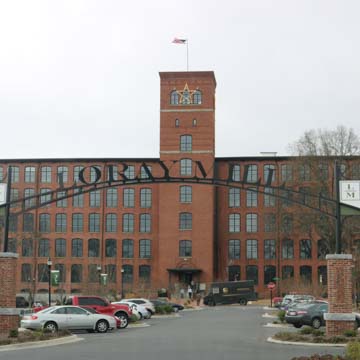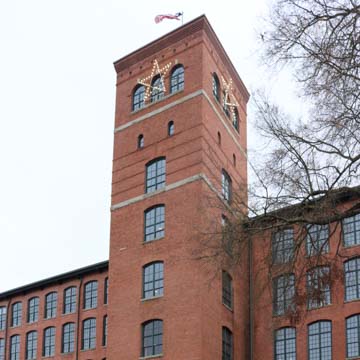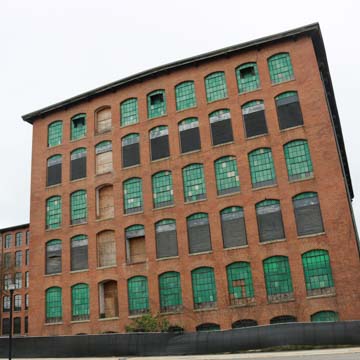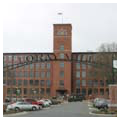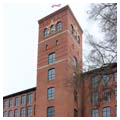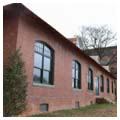You are here
Loray Mill
Loray Mill and Village exemplifies the growth and decline of the textile industry in North Carolina. Like other towns in the Piedmont region, Gaston County had been a hub for the cotton and textile industry since the mid-1800s, with the Catawba River and its tributaries providing a source of power. Most of these early mills were small in scale and run by local businessmen. In 1902, Gaston County businessmen John Love and George Gray developed Loray Mill on the west side of Gastonia. The five-story mill, with its eight-story tower, encompassed over 350,000 square feet, making it the largest textile mill in the South, with a workforce of over 1,000.
Nicknamed the “Million Dollar Mill” by local newspapers because of its grand size and high capital investment by northern bankers, businessmen, and manufacturing equipment purchasers, Loray Mill and the surrounding village was designed by the prominent Boston engineering firm Lockwood, Greene and Company—experts in the newest textile mill technologies. The mill increased Gaston County’s output of cotton goods by 40 percent.
The enormous mill has an austere appearance. At over 500 feet long, the main elevation features thick brick walls with repetitive, arched-top vertical windows that provide abundant daylight to each floor. The tower, offset to the east side of the building, punctuates the rhythmic front facade. Simple brick corbeling and soldier courses provide basic ornament, lending the facade a dignified appearance. The design is based on textile mill antecedents from New England—a style that translated very effectively to North Carolina because of the abundance of local wood and brick.
The mill design was technologically significant in terms of structural, mechanical, and fire-resistant systems. Textiles mills were susceptible to fire because of the manufacturing processes and the combustible cotton and lint materials. Loray is an excellent example of slow-burning mill architecture: the heavy timber frame would allow the structure to maintain its integrity (for a sufficient time) if subjected to fire, while exterior masonry walls are inherently fireproof; firewalls partition the interior in order to limit the spread of fire; and the floors consist of layers of solid wood planks laid directly on top of support beams. The tower, with its Italianate details, arched windows, and low-pitched pyramidal roof, houses the stairs, elevators, and a ropeway. It is separated from the main floors by brick firewalls and automatically actuating fire doors—a necessary feature for the chimney-like tower. Other technological advances included experimental steam power and air conditioning systems. Using steam as a power source meant that the mill did not have to be built on a riverside site. Love and Gray struggled to maintain the capital needed for such a large mill, and sold it to the Jenckes Spinning Company (later Manville-Jencks Company) in 1921. The new owner added a sixth floor and basement to the mill to increase its floor area.
The mill building dominates a village of small, wooden houses constructed for its workers. Located primarily to the northwest and in walking distance of the mill, the village of tenement worker housing grew from 250 houses to 625. They were based on several basic patterns, each with small porches and simple rectangular or T-shaped floor plans. The one- and one-and-a-half-story houses feature gable roofs, brick chimneys, double-hung windows, and weatherboard siding. Small yards offered residents space for vegetable gardens. Many of these houses still exist, though most have been altered with additions, repairs, and renovations. Male and female dormitories provided alternative housing, and small churches and a recreation field offered places of worship and public gathering spaces, respectively, for the millworkers.
On April 1, 1929, the American Communist Party and its new organization, the National Textile Workers Union (NTWU), led 1,800 mill workers in a strike that became part of the national and international discussion of workers’ rights and class warfare. Many workers returned to the mill by April 15, but events and violence continued throughout the summer, culminating on June 7 with a violent riot that resulted in the death of police chief Orville Aderholt and union activist Elle Mae Wiggins. The murder trials received national press and anti-union sentiment among Gaston County citizens resulted in the end of the strike, and the hindrance of several future attempts to unionize the local mills.
The strike negatively impacted business and, combined with the national economic downturn, Manville-Jenckes ultimately filed for bankruptcy and sold the mill to Firestone Tire and Rubber Company in 1935. Firestone produced textiles for tires until its permanent closure as a manufacturing facility in 1993, when the company moved to a new plant in Kings Mountain. Firestone donated the mill to Preservation North Carolina in 1998, thereby preventing its demolition. In 2012, Preservation North Carolina sold it to developer Billy Hughes, who began a multi-phase renovation to transform Loray Building into a mixed-use facility with 189 loft apartments and 80,000 square feet of retail and commercial space.
References
Hughes, C.J. “A Historic Textile Mill Begins a New Chapter.” New York Times, May 7, 2013.
John Locke Foundation. “Gaston County (1846).” North Carolina History Project. Accessed March 11, 2019. http://www.northcarolinahistory.org/.
“Loray Mill,” Gaston County, North Carolina. Historic American Engineering Record Survey, 2000. Prints and Photographs Division, Library of Congress (HAER No. NC-45. 2000).
North Carolina Office of Archives and History, Department of Cultural Resources. “Marker: O-81.” North Carolina Highway Historical Marker Program. Accessed March 11, 2019. http://www.ncmarkers.com/.
Mock, Gary. “Loray Mills, Gastonia, NC.” Textile Industry History. Accessed March 11, 2019. http://www.textilehistory.org/.
Ragan, Robert Allison. “Loray Mills, Gastonia, 1900.” In The Textile Heritage of Gaston County, North Carolina, 1848-2000. Charlotte, NC: R.A. Ragan and Company, 2001.
Writing Credits
If SAH Archipedia has been useful to you, please consider supporting it.
SAH Archipedia tells the story of the United States through its buildings, landscapes, and cities. This freely available resource empowers the public with authoritative knowledge that deepens their understanding and appreciation of the built environment. But the Society of Architectural Historians, which created SAH Archipedia with University of Virginia Press, needs your support to maintain the high-caliber research, writing, photography, cartography, editing, design, and programming that make SAH Archipedia a trusted online resource available to all who value the history of place, heritage tourism, and learning.














